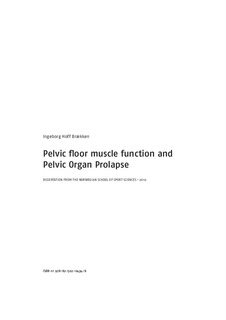| dc.contributor.author | Brækken, Ingeborg Hoff | |
| dc.date.accessioned | 2010-02-04T11:23:14Z | |
| dc.date.issued | 2010 | |
| dc.identifier | Seksjon for idrettsmedisinske fag / Department of Sports Medicine | |
| dc.identifier.isbn | 978-82-502-0434-8 | |
| dc.identifier.uri | http://hdl.handle.net/11250/171285 | |
| dc.description | Avhandling (doktorgrad) – Norges idrettshøgskole, 2010. | en |
| dc.description.abstract | The overall high prevalence of pelvic organ prolapse (POP) and related problems indicates a
need for identification of risk factors, prevention and treatment strategies. The aetiology of
POP is considered to be multifactorial. Only a minority of the many proposed risk factors for
POP can easily be prevented. Treatment of POP is surgery, use of a pessary or pelvic floor
muscle training (PFMT). Today there is a lack of evidence for the effect of PFMT in reducing
and preventing POP, and there is scant knowledge of possible changes in morphology and
function of the pelvic floor muscles (PFM) following PFMT. Proposed changes in the pelvic
floor include increased muscle volume, elevated positions of the pelvic organs and narrowing
of the levator hiatus. Use of responsive, reliable and valid outcome measures is mandatory for
evaluation of these proposed effects. 3D/ 4D perineal ultrasound is a new promising
assessment tool. However, its reliability and validity must first be tested. The overall aim of
this thesis was to establish intra tester reliability of the ultrasound measurements, identify risk
factors for POP, evaluate the effect of PFMT in prevention and treatment of women with POP
and to assess morphological changes after PFMT. | en |
| dc.description.abstract | Paper I: Tatt ut av filen i Brage p.g.a. copyright-restriksjoner. / Not in the file in Brage because of copyright issues. | |
| dc.description.abstract | Paper II: Tatt ut av filen i Brage p.g.a. copyright-restriksjoner. / Not in the file in Brage because of copyright issues. | |
| dc.description.abstract | Paper III: Tatt ut av filen i Brage p.g.a. copyright-restriksjoner. / Not in the file in Brage because of copyright issues. | |
| dc.description.abstract | Paper IV: Braekken,I.H., Majida,M., Ellström-Engh,M. and Bø,K., Can pelvic floor muscle training
reverse pelvic organ prolapse and reduce prolapse symptoms? – An assessor blinded
randomized controlled trial, accepted American Journal of Obstetrics and Gynecology 22.
December 2009, Manuscript number: W09-0796R1 | |
| dc.description.abstract | Paper V: Tatt ut av filen i Brage p.g.a. copyright-restriksjoner. / Not in the file in Brage because of copyright issues. | |
| dc.format.extent | 3959056 bytes | |
| dc.format.mimetype | application/pdf | |
| dc.language.iso | eng | en |
| dc.subject | bekkenbunnen | en |
| dc.subject | forebygging | en |
| dc.subject | trening | en |
| dc.subject | prolaps | en |
| dc.title | Pelvic floor muscle function and pelvic organ prolapse | en |
| dc.type | Doctoral thesis | en |
| dc.subject.nsi | VDP::Medical disciplines: 700::Health sciences: 800 | |
| dc.subject.nsi | VDP::Medical disciplines: 700::Clinical medical disciplines: 750 | |
| dc.subject.nsi | VDP::Medical disciplines: 700 | |
| dc.subject.nsi | VDP::Medical disciplines: 700::Clinical medical disciplines: 750::
Gynecology and obstetrics: 756 | |
| dc.subject.nsi | VDP::Medical disciplines: 700::Basic medical, dental and veterinary science disciplines: 710 | |
